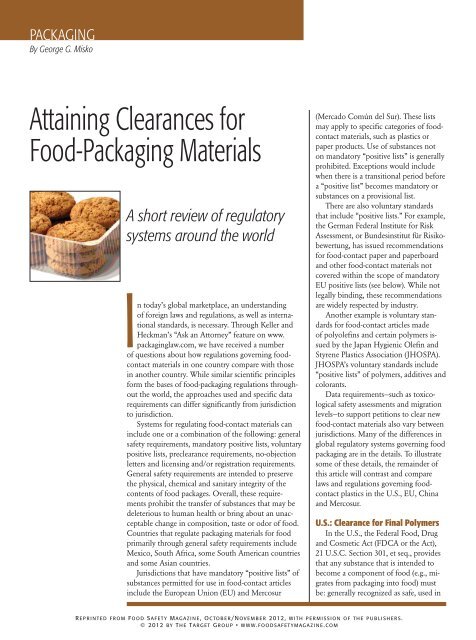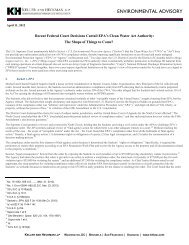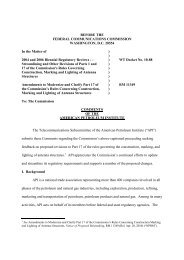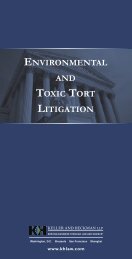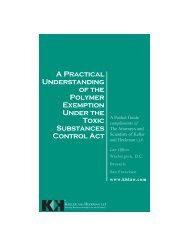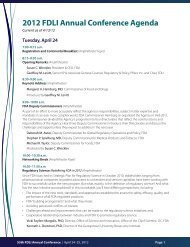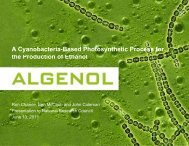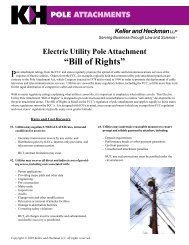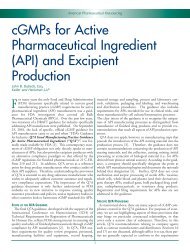Attaining Clearances for Food-Packaging Materials - Keller Heckman
Attaining Clearances for Food-Packaging Materials - Keller Heckman
Attaining Clearances for Food-Packaging Materials - Keller Heckman
Create successful ePaper yourself
Turn your PDF publications into a flip-book with our unique Google optimized e-Paper software.
PACKAGING<br />
By George G. Misko<br />
<strong>Attaining</strong> <strong>Clearances</strong> <strong>for</strong><br />
<strong>Food</strong>-<strong>Packaging</strong> <strong>Materials</strong><br />
A short review of regulatory<br />
systems around the world<br />
In today’s global marketplace, an understanding<br />
of <strong>for</strong>eign laws and regulations, as well as international<br />
standards, is necessary. Through <strong>Keller</strong> and<br />
<strong>Heckman</strong>’s “Ask an Attorney” feature on www.<br />
packaginglaw.com, we have received a number<br />
of questions about how regulations governing foodcontact<br />
materials in one country compare with those<br />
in another country. While similar scientific principles<br />
<strong>for</strong>m the bases of food-packaging regulations throughout<br />
the world, the approaches used and specific data<br />
requirements can differ significantly from jurisdiction<br />
to jurisdiction.<br />
Systems <strong>for</strong> regulating food-contact materials can<br />
include one or a combination of the following: general<br />
safety requirements, mandatory positive lists, voluntary<br />
positive lists, preclearance requirements, no-objection<br />
letters and licensing and/or registration requirements.<br />
General safety requirements are intended to preserve<br />
the physical, chemical and sanitary integrity of the<br />
contents of food packages. Overall, these requirements<br />
prohibit the transfer of substances that may be<br />
deleterious to human health or bring about an unacceptable<br />
change in composition, taste or odor of food.<br />
Countries that regulate packaging materials <strong>for</strong> food<br />
primarily through general safety requirements include<br />
Mexico, South Africa, some South American countries<br />
and some Asian countries.<br />
Jurisdictions that have mandatory “positive lists” of<br />
substances permitted <strong>for</strong> use in food-contact articles<br />
include the European Union (EU) and Mercosur<br />
(Mercado Común del Sur). These lists<br />
may apply to specific categories of foodcontact<br />
materials, such as plastics or<br />
paper products. Use of substances not<br />
on mandatory “positive lists” is generally<br />
prohibited. Exceptions would include<br />
when there is a transitional period be<strong>for</strong>e<br />
a “positive list” becomes mandatory or<br />
substances on a provisional list.<br />
There are also voluntary standards<br />
that include “positive lists.” For example,<br />
the German Federal Institute <strong>for</strong> Risk<br />
Assessment, or Bundesinstitut für Risikobewertung,<br />
has issued recommendations<br />
<strong>for</strong> food-contact paper and paperboard<br />
and other food-contact materials not<br />
covered within the scope of mandatory<br />
EU positive lists (see below). While not<br />
legally binding, these recommendations<br />
are widely respected by industry.<br />
Another example is voluntary standards<br />
<strong>for</strong> food-contact articles made<br />
of polyolefins and certain polymers issued<br />
by the Japan Hygienic Olefin and<br />
Styrene Plastics Association (JHOSPA).<br />
JHOSPA’s voluntary standards include<br />
“positive lists” of polymers, additives and<br />
colorants.<br />
Data requirements—such as toxicological<br />
safety assessments and migration<br />
levels—to support petitions to clear new<br />
food-contact materials also vary between<br />
jurisdictions. Many of the differences in<br />
global regulatory systems governing food<br />
packaging are in the details. To illustrate<br />
some of these details, the remainder of<br />
this article will contrast and compare<br />
laws and regulations governing foodcontact<br />
plastics in the U.S., EU, China<br />
and Mercosur.<br />
U.S.: Clearance <strong>for</strong> Final Polymers<br />
In the U.S., the Federal <strong>Food</strong>, Drug<br />
and Cosmetic Act (FDCA or the Act),<br />
21 U.S.C. Section 301, et seq., provides<br />
that any substance that is intended to<br />
become a component of food (e.g., migrates<br />
from packaging into food) must<br />
be: generally recognized as safe, used in<br />
R e p r i n t e d f r o m <strong>Food</strong> Saf et y Mag a z i n e, Octo b e r/Nov e m b e r 2012, with p e r m i s s i o n of th e p u b l i s h e r s.<br />
© 2012 by Th e Target Grou p • w w w.foodsaf et y m ag a z i n e.co m
PACKAGING<br />
accordance with a sanction or approval<br />
issued prior to 1958 by either the U.S.<br />
<strong>Food</strong> and Drug Administration (FDA) or<br />
the U.S. Department of Agriculture, the<br />
subject of a “Threshold of Regulation”<br />
exemption letter or cleared by a <strong>Food</strong><br />
Contact Notification or a food additive<br />
regulation.<br />
Polymers cleared <strong>for</strong> food-contact use<br />
by FDA are listed in Title 21 of the Code<br />
of Federal Regulations<br />
(C.F.R.), Part 177,<br />
“Indirect <strong>Food</strong> Additives:<br />
Polymers.” Part<br />
177 is further divided<br />
by types of polymers.<br />
For example, Section<br />
177.1520 lists cleared<br />
polyolefin polymers<br />
and Section 177.1630<br />
lists cleared polyethylene<br />
phthalate polymers.<br />
For plastic packaging<br />
materials, FDA<br />
regulations clear the<br />
final polymer, not unreacted starting<br />
materials. There are, however, some<br />
instances in which FDA does not clear<br />
the polymer per se, but rather permits<br />
any of a number of starting reactants to<br />
be used to make a finished polymer. For<br />
example, in the case of adhesives, Part<br />
175.105 lists substances cleared by FDA<br />
that may be used in adhesive <strong>for</strong>mulations<br />
intended <strong>for</strong> food contact.<br />
Another exception is found in Part<br />
175.300, “Resinous and polymeric coatings.”<br />
Since these substances are typically<br />
complex and often cross-linked compounds,<br />
FDA lists cleared precursor materials<br />
in this regulation. In either case,<br />
however, substances required to produce<br />
a functional polymer, such as catalysts,<br />
chain regulators, chain transfer agents<br />
and similar materials used at low levels<br />
(generally 1% or below), are typically<br />
considered part of the basic resin and do<br />
not require independent regulatory consideration<br />
by FDA.<br />
<strong>Food</strong> additive clearances may have<br />
quantitative limitations and end-test<br />
requirements. More specifically, they<br />
may limit the types of food that will be<br />
“Many of the<br />
differences in global<br />
regulatory systems<br />
governing food<br />
packaging are in the<br />
details.”<br />
contacted, the maximum temperature at<br />
which a material may be used or the type<br />
of application (repeated-use versus singleuse).<br />
Any food-packaging material intended<br />
to come in contact with food must<br />
comply with FDA’s Good Manufacturing<br />
Practices (GMP) regulation, found in<br />
Title 21 C.F.R., Part 174.5. GMP requirements<br />
apply to both the use level of an<br />
additive as well as to<br />
its suitable purity. This<br />
means that additives<br />
may only be used in<br />
an amount necessary<br />
to achieve their function<br />
or purpose, and<br />
must also not contain<br />
impurities at levels so<br />
high as to result in the<br />
adulteration of food.<br />
In passing the<br />
FDCA, the U.S.<br />
Congress decided to<br />
exclude “housewares”<br />
from the need <strong>for</strong><br />
FDA premarket clearance requirements<br />
<strong>for</strong> food additives. Housewares are finished<br />
articles sold without prepackaged<br />
food and used by consumers in the<br />
home to hold, prepare or serve food.<br />
Importantly, housewares are not exempt<br />
from the general safety requirements of<br />
the Act and, there<strong>for</strong>e, must be suitable<br />
<strong>for</strong> use with food so as not to result in its<br />
adulteration.<br />
Since the <strong>Food</strong> Contact Notification<br />
(FCN) program was implemented in<br />
2000, it has become the preferred method<br />
to obtain FDA clearance <strong>for</strong> new<br />
food-contact substances. Under the FCN<br />
program, a manufacturer or supplier of<br />
a food-contact material may submit an<br />
FCN that includes the identity and intended<br />
use of the new food-contact substance,<br />
along with in<strong>for</strong>mation supporting<br />
the conclusion that the substance is<br />
safe <strong>for</strong> its intended use.<br />
In contrast to the traditional food<br />
additive petition process, which requires<br />
a lengthy rulemaking process, FDA has<br />
only 120 days from the filing of an FCN<br />
to complete its review of the notification.<br />
Another difference from the old<br />
petitioning process is that FCNs are<br />
proprietary, that is, only the notifier/<br />
manufacturer and its customers can rely<br />
on them.<br />
EU: Positive List of Monomers and<br />
Additives<br />
Plastics Regulation (EU) No. 10/2011<br />
governs the use of plastic materials and<br />
articles intended to contact food in the<br />
EU. It includes a positive list of permissible<br />
monomers and other starting<br />
substances, and additives (other than<br />
colorants). It also includes some polymer<br />
production aids (PPAs); however, PPAs<br />
not on the positive list can be used in<br />
food-contact plastics, subject to the national<br />
laws of individual Member States.<br />
The Plastics Regulation also establishes<br />
an overall migration limit (OML)<br />
of 10 mg/dm 2 <strong>for</strong> all plastics in contact<br />
with food, unless the use is subject to<br />
an exemption. Specific migration limits<br />
(SMLs) and residual quantity in the material<br />
(QM) limits <strong>for</strong> certain substances<br />
also are specified. For substances not<br />
subject to an SML (or similar limitation),<br />
a generic default SML of 60 mg/kg is applied.<br />
The Plastics Regulation introduced<br />
a separate testing scheme to verify compliance<br />
with OMLs and set new time<br />
and temperature parameters <strong>for</strong> SML<br />
compliance testing. These changes are<br />
being phased in.<br />
Unlike U.S. regulations, the EU Plastics<br />
Regulation does not include limits<br />
on coreactants or use levels <strong>for</strong> starting<br />
materials, temperature restrictions, specification<br />
of single versus repeated use and<br />
food types <strong>for</strong> specific substances.<br />
Printing inks, adhesives and coatings<br />
are not covered by the Plastics Regulation<br />
and, there<strong>for</strong>e, are subject to Member<br />
State national laws. However, since<br />
the Plastics Regulation includes within<br />
its scope printed plastic articles, components<br />
used in printing inks that are on<br />
the Plastics Regulation’s positive list and<br />
have SMLs or other restrictions must<br />
comply with those limitations when<br />
used on plastic articles.<br />
Anyone can petition to add a new<br />
monomer or additive to the Plastics<br />
Regulation’s positive list. These petitions<br />
R e p r i n t e d f r o m <strong>Food</strong> Saf et y Mag a z i n e, Octo b e r/Nov e m b e r 2012, with p e r m i s s i o n of th e p u b l i s h e r s.<br />
© 2012 by Th e Target Grou p • w w w.foodsaf et y m ag a z i n e.co m
PACKAGING<br />
are first reviewed by the European <strong>Food</strong><br />
Safety Authority (EFSA), which will issue<br />
a <strong>for</strong>mal opinion on the safety of the<br />
substance when intended <strong>for</strong> use with<br />
food and any limitations that should be<br />
observed.<br />
Once EFSA has<br />
issued an opinion,<br />
finding a proposed<br />
use of a substance<br />
to be safe, the European<br />
Commission<br />
(EC), provided it<br />
concurs with the<br />
opinion, will add the<br />
substance to the list<br />
through an amendment<br />
to the regulation.<br />
Finally, all foodcontact<br />
materials in<br />
the EU must comply<br />
with the safety<br />
criteria requirements<br />
set <strong>for</strong>th in Framework<br />
Regulation<br />
(EC) No. 1935/2004, which covers basic<br />
requirements (e.g., GMPs and the like)<br />
applicable to the use of all food-contact<br />
materials in the EU.<br />
“Data requirements—<br />
such as toxicological<br />
safety assessments<br />
and migration levels—<br />
to support petitions<br />
to clear new foodcontact<br />
materials...vary<br />
between jurisdictions.”<br />
China: Approval Required <strong>for</strong> All<br />
<strong>Food</strong>-<strong>Packaging</strong> <strong>Materials</strong><br />
China’s <strong>Food</strong> Safety Law requires<br />
approval of all “food-related products,”<br />
including food-packaging materials. Additionally,<br />
it prohibits the importation,<br />
use or purchase of food-related products<br />
that do not comply with applicable Chinese<br />
standards. China is in the process<br />
of “harmonizing” the GB (Guobiao, or<br />
“National”) Standards that were in place<br />
prior to the effective date of the current<br />
law (June 1, 2009) with its <strong>Food</strong> Safety<br />
Law and converting them to <strong>Food</strong> Safety<br />
Standards. Until this process is complete,<br />
all packaging materials must comply<br />
with all existing GB Standards.<br />
One of China’s GB Standards, “Hygienic<br />
Standards <strong>for</strong> Uses of Additives in<br />
<strong>Food</strong> Containers and <strong>Packaging</strong> <strong>Materials</strong>”<br />
(GB 9685), includes a positive list<br />
of additives permitted <strong>for</strong> use in foodpackaging<br />
materials and covers polymers,<br />
coatings and adhesives. Initially, the list<br />
consisted of 959 additives despite the<br />
fact that there were numerous other<br />
food-contact substances in use in China<br />
at the time. Accordingly, Chinese authorities<br />
established<br />
procedures <strong>for</strong> clearing<br />
the use of additives and<br />
resins that were being<br />
marketed in China at<br />
that time, but were not<br />
on the GB 9685-<br />
positive list. This resulted<br />
in the submission<br />
of some 3,000 petitions<br />
under those procedures,<br />
which were referred to as<br />
“cleanup” submissions<br />
or “grandfather” petitions.<br />
In response to these<br />
petitions, China has<br />
cleared an additional<br />
107 resins and 301 additives<br />
<strong>for</strong> food-contact<br />
use, although additional<br />
specifications <strong>for</strong> the resins and/or corresponding<br />
finished article standards are<br />
still being considered by the Chinese<br />
Ministry of Health (MOH). The MOH<br />
also is in the process of reviewing the<br />
remaining cleanup petitions. The final<br />
list of approvals, in addition to a negative<br />
list of substances prohibited from<br />
use in food packaging, is expected to be<br />
published by the end of 2012. Recently,<br />
China announced plans to revise GB<br />
9685 by June 2013, but that deadline<br />
may be optimistic.<br />
Procedures <strong>for</strong> clearing new resins<br />
and additives <strong>for</strong> use in food-packaging<br />
materials are included in China’s Management<br />
Rules <strong>for</strong> the Administrative<br />
Approval of New Varieties of <strong>Food</strong><br />
Related Products (the rules), which were<br />
issued on June 1, 2011. Article 3 of the<br />
rules sets out the requirements <strong>for</strong> petitions<br />
intended to clear new food-related<br />
products, including packaging materials.<br />
Specifically, petitions should demonstrate<br />
that a substance: has a clear scope<br />
of use; is technically necessary; will not<br />
negatively impact human health under<br />
ordinary/reasonable uses or alter the ingredients,<br />
structure, color or flavor of the<br />
food; and will be used at the lowest level<br />
needed to achieve the desired technical<br />
effect. In addition, an accompanying<br />
guidance document (guidance) details<br />
data requirements not specified in the<br />
rules.<br />
In this regard, toxicology data requirements<br />
are set out based on projected<br />
levels of migration. Additionally,<br />
toxicological testing must be conducted<br />
in accordance with Good Laboratory<br />
Practices. Although testing does not<br />
have to be conducted in China, if it is<br />
done there, the lab must be governmentaccredited.<br />
Mercosur: Recently Revised<br />
Positive Lists of Monomers and<br />
Polymers<br />
Mercosur, also referred to as the<br />
“Common Market of the South,” is the<br />
largest trading bloc in South America.<br />
Current members include Argentina,<br />
Brazil, Paraguay, Uruguay and Venezuela.<br />
(As of July 31, 2012, Paraguay was<br />
suspended but remains a full member.)<br />
Mercosur established general safety criteria<br />
applicable to all food-contact materials<br />
in 1992 under GMC Resolution<br />
No. 3/92. Specifically, this resolution<br />
requires that all food-contact materials:<br />
1) be manufactured in accordance with<br />
GMPs; 2) be of suitable purity; 3) not<br />
transfer any harmful or toxic compounds<br />
from the packaging to the food and 4)<br />
not cause any unacceptable changes in<br />
food composition, taste or odor. Mercosur’s<br />
general standards <strong>for</strong> food-contact<br />
materials apply to housewares and foodprocessing<br />
equipment other than drinking<br />
water equipment.<br />
Mercosur also has issued GMC resolutions<br />
applicable to some specific categories<br />
of food-contact materials, including<br />
plastics, elastomers and adhesives.<br />
GMC Resolution No. 02/12, “Mercosur<br />
Technical Regulation on Positive List of<br />
Monomers, Other Starting Substances<br />
and Polymers Authorized <strong>for</strong> the Manufacture<br />
of Plastic <strong>Packaging</strong> and Equipment<br />
that Come into Contact with<br />
<strong>Food</strong>,” was recently adopted and must<br />
be incorporated into the national legisla-<br />
R e p r i n t e d f r o m <strong>Food</strong> Saf et y Mag a z i n e, Octo b e r/Nov e m b e r 2012, with p e r m i s s i o n of th e p u b l i s h e r s.<br />
© 2012 by Th e Target Grou p • w w w.foodsaf et y m ag a z i n e.co m
PACKAGING<br />
tion of member countries by November<br />
1, 2012.<br />
The resolution has five parts: 1) a<br />
list of monomers and other starting<br />
substances with usage restrictions, composition<br />
limits and SMLs; 2) a list of<br />
products obtained by bacterial fermentation;<br />
3) general specifications; 4) notes<br />
related to “restrictions and/or specifications”<br />
and 5) a list of polymers obtained<br />
from monomers listed in Part 1 and/or<br />
polymers included in Part 2 and/or other<br />
polymers.<br />
The positive lists <strong>for</strong> additives (found<br />
in GMC Res. 32/07) cover substances<br />
added to plastic to obtain a desired effect<br />
(e.g., antioxidants, foaming agents, lubricants<br />
and plasticizers) and substances<br />
used to produce an appropriate polymerization<br />
medium (e.g., wetting agents,<br />
surfactants and solvents). Separate resolutions<br />
address test methods, including<br />
one <strong>for</strong> determining overall migration<br />
values (GMC Res. 32/10). Reusable plastics<br />
are generally banned, with certain<br />
exceptions.<br />
The general requirements to add a<br />
new substance to a positive list are found<br />
in GMC Res. 31/99. Petitions must be<br />
submitted to either the Argentina National<br />
<strong>Food</strong> Commission (CONAL) or<br />
the Brazil National Agency of Sanitary<br />
Surveillance (ANVISA). Once either<br />
CONAL or ANVISA deem a petition<br />
acceptable, it is <strong>for</strong>warded to Mercosur.<br />
Generally, if a substance is cleared in the<br />
EU or U.S., the submitter can expect it<br />
to be adopted by Mercosur with similar<br />
limitations (e.g., SMLs, QMs and types<br />
of food).<br />
Conclusions<br />
To determine whether a food package<br />
can be legally marketed in jurisdictions<br />
around the globe, one has to consider<br />
numerous factors, beginning with the<br />
composition of the package, the food or<br />
beverage intended to be packaged and<br />
the conditions to which the package will<br />
be subjected during manufacturing and<br />
use.<br />
However, it is not a one-size-fits-all<br />
kind of world, as there are many subtle<br />
differences from region to region in the<br />
data requirements and in the manner in<br />
which these products are regulated. •<br />
George G. Misko is a partner in the<br />
Washington, D.C., office of <strong>Keller</strong><br />
and <strong>Heckman</strong> LLP. His practice focuses<br />
on food and drug matters and<br />
environmental concerns, including<br />
pesticide regulation and chemical<br />
control regulations. He has extensive experience counseling<br />
clients on regulatory requirements relating to<br />
chemical substances, plastics and food products in the<br />
U.S. and other jurisdictions, including Canada, the EU,<br />
Latin America and the Pacific Rim. He also represents<br />
trade associations, including acting as general counsel<br />
to the Silicones Environmental, Health and Safety<br />
Council. Misko also has experience in civil trial and<br />
appellate matters. He can be reached at<br />
misko@khlaw.com.<br />
For more in<strong>for</strong>mation on packaging solutions,<br />
please visit www.foodsafetymagazine.com/<br />
signature.asp.<br />
R e p r i n t e d f r o m <strong>Food</strong> Saf et y Mag a z i n e, Octo b e r/Nov e m b e r 2012, with p e r m i s s i o n of th e p u b l i s h e r s.<br />
© 2012 by Th e Target Grou p • w w w.foodsaf et y m ag a z i n e.co m


